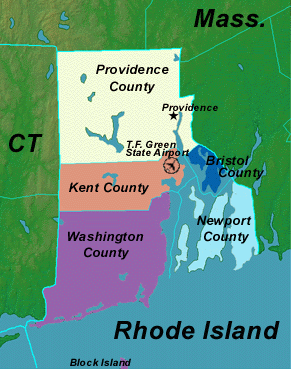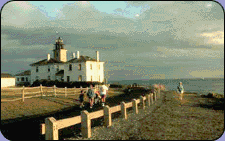About Rhode Island






Moving to Rhode Island? Rhode Island attracts those seeking the advantages of an exciting city or relaxing country life. Less than 50 miles wide, but graced with a 400 mile shoreline, Rhode Island focuses naturally on the ocean and beautiful Narragansett Bay. A rich saltwater heritage makes Rhode Island one of the sailing capitals of the world. Fresh and salt water fishing, swimming at more than 100 beaches, camping, music festivals, picnicking, surfing, skin diving, and old fashioned clambakes make Rhode Island's summer an outdoor paradise.
Rhode Island Regions
Northern Rhode Island, including the bustling capital, Providence, is an area of wide expanses of quiet woodland and lake country. Northern Rhode Island is the birthplace of the American Industrial Revolution at the Old Slater Mill, the home of Brown University, the site of the State Capitol, the First Baptist Church in America built in 1775, and the Arcade, America's first shopping mall. Providence's Benefit Street, called a mile of history," began as an Indian trail and was the social, intellectual, governmental, and artistic center of Providence County, offering an abundance of outdoor activities from hiking and canoeing to freshwater fishing.
Southern Rhode Island boasts some of the country's finest beaches, salt water fishing, boating, resorts, art colonies, shoreline campgrounds and extensive woodland recreation areas. Its rich Colonial and Indian lore is preserved in numerous historic shrines. Wickford Village, on Narragansett Bay, has one of New England's largest concentrations of varied 18th century buildings and homes and is considered the largest yachting center in New England.
The City of Newport, founded in 1639, became world famous early as a commercial seaport. Numerous colonial landmarks remain standing and preserved. The city-by-the-sea is home of international sailboat races, and the site of the palatial "summer cottages" of the country's leading socialites at the turn of the century. Newport is the home of the White Horse Tavern (1673), America's oldest continuously operated tavern; Touro Synagogue (1763), the oldest Jewish home of worship in the United States; and Fort Adams (1799), the second largest fortification on the Atlantic seaboard.
East Bay- Sailing and shipbuilding have played an important role in the life along the east shores of Narragansett Bay since the 17th century. The famous Herreshoff Boatyard, where the seven America's Cup defenders were built, shares the coastline with old fishing villages and century-old homes.
West Bay is characterized by meadowland and suburban residential development. Sailing, clam digging, antique hunting, shopping in the state's commercial center, and visiting the historic homesteads of General Nathaniel Greene and James Mitchell Varnum are rewarding activities.

There are five counties in Rhode Island_ Providence County, Bristol County, Kent County, Newport County and Washington County. The state is divided into 39 municipalities ranging in size from 1.3 to 64.8 square miles. There is no county government. The type of local governments range from Mayor, administrator or manager and council to town council. Many of the rural towns continue the traditional New England Town Meeting form of government. In Rhode Island, local communities maintain control in areas such as primary and secondary education, subdivision of land, and zoning. The principal source of municipal revenue is the local property tax.
Elementary and Secondary Education
The overall responsibilty for public education in Rhode Island is delegated to the State Board of Regents. School committees govern local schools and meet uniform standards set by the Board. All schools provide kindergarten classes, special education classes, and transportation for special education students. Parochial schools are available in most communities. Proprietary schools, nusery schools, and daycare centers operate under state supervision.
In 1996, there were 148,978 students enrolled in Rhode Island's 36 public school districts and another 25, 075 in private schools for a total of 174,052 students.
Rhode Island high schools graduated 7,734 students in 1996.
Rhode Island spends about 27.8% of its total state revenue on education. Local communities spend over 52.8% of their property tax on education. The total expenditure per pupil for the 1996 school year was $7,733.
Photographs and information courtesy of the Rhode Island Economic Development Corporation Research Division
RE/MAX Coast and Country
Donna Sormanti-Saglio,
ABR, CRS, GRI, SRES,
e-PRO Certified Internet Professional
530 Stonington Rd. Ste. 101
Stonington, CT 06378
Office 860.535.9009
Toll Free 1.877.8REMAX9

Newsletter

Copyright Donna Sormanti-Saglio
All rights reserved



Home / About RI / Client Services / Buyers / Sellers / FSBOs / Newsletter / Featured Property / School Reports / Contact Info / Seniors Only / Realtor Only
Thank you for visiting my "home" site!
Welcome